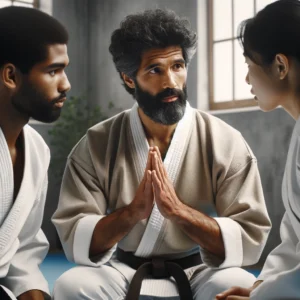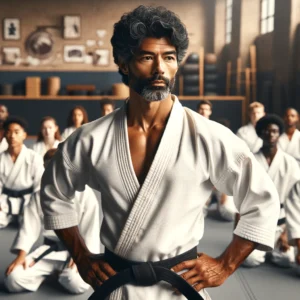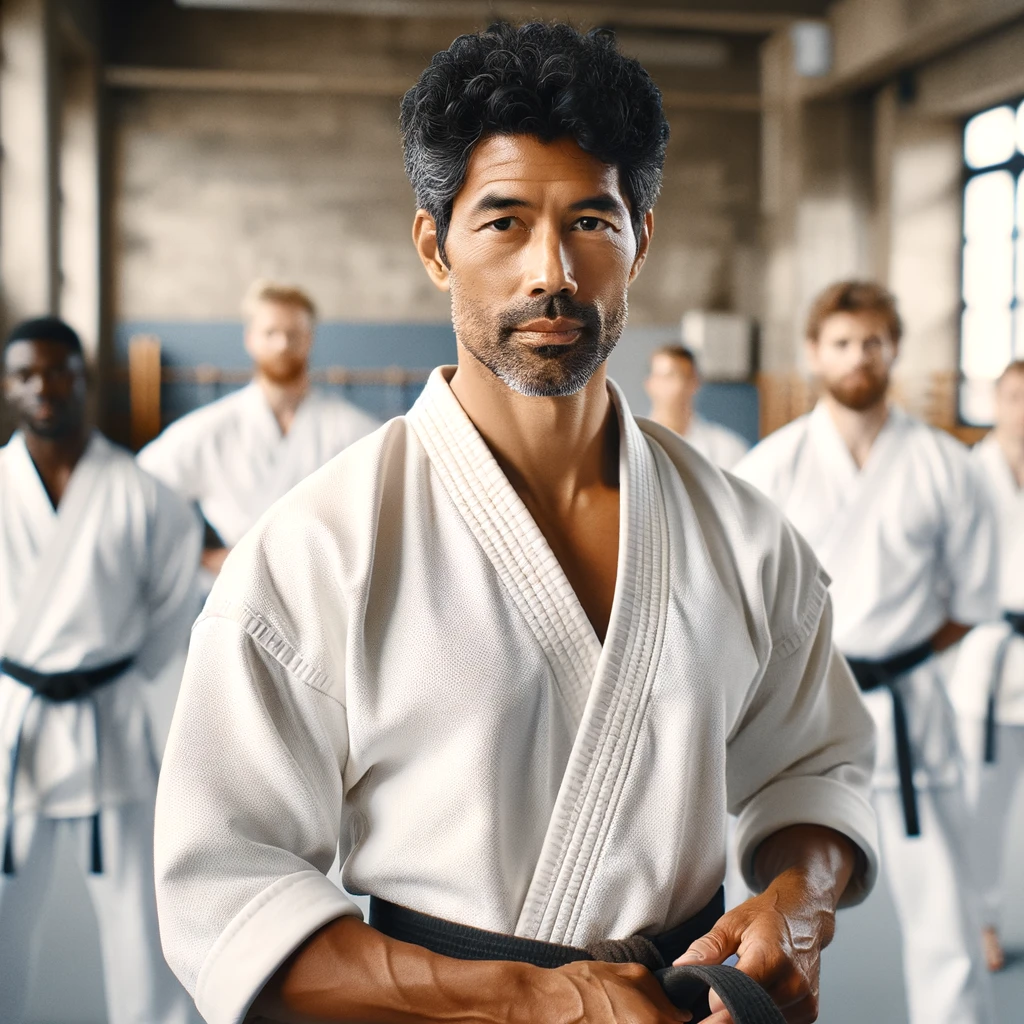Territorial Possessiveness in the Dōjō
All Gojuryu Network (www.gojuryu.network) & SKSV (Gojuryu.net) cross-post
By Johnpaul Williams – Feb 13, 2024
Introduction
“At our club in the 1990s, I wasn’t the ‘King of the Dōjō’—that was a tacit moniker reserved for our Shihan (Sensei). I was the Big Man on Campus (BMOC) and reigned as undisputed champion on the dōjō floor. That was until Eric R. joined the dōjō…”
This reminiscent opening could serve as the opening line of a short novel, a teen-screenplay or compelling narrative, echoing the sentiments and experiences of numerous Karateka (空手家) across the globe. Territorial possessiveness, a phenomenon not unique to but significantly pronounced in the environments of dōjō and karate clubs, emerges as a focal point of intrigue. Such behavior, marked by a domineering presence and a bid for control over a shared space, is not an anomaly confined to select individuals; it is a universal occurrence across martial arts communities, a nuanced interplay of psychological, cultural, and social dynamics….. And I too have served as the protagonist, the antagonist and the intermediary arbitrator. Yet, the acknowledgment and management of territorial possessiveness vary widely. Not every dōjō, club, or group recognizes the dual-edged sword this behavior represents—its potential benefits and liabilities. Identifying, nurturing, or constraining these actions can fortify the collective strength of a team, transcending the sum of its parts.
Gender Dynamics

Conflict resolution requires communication in the Dojo
Contrary to the implications of the term, “Territorial Possessiveness,” this dynamic is not exclusive to men. Women, too, exhibit proprietorial behaviors, arguably with greater frequency and intensity. The underlying mechanisms—rooted in psychology and group dynamics—challenges gender stereotypes, highlighting a universal aspect of human behavior within competitive and communal settings, advocating for inclusivity and diversity in modern martial arts practice.
Historical and Cultural Context
In traditional Japanese dōjō (道場), respect and hierarchy are deeply ingrained, often mitigating overt territorial behaviors. However, in Western adaptations of martial arts, there’s a noticeable shift. The Western emphasis on individual achievement can sometimes amplify these territorial tendencies. Exploring these cultural contrasts offers insights into managing such dynamics effectively.
Recognizing Territorial Possessiveness
When Erik R came along, he was new to the Dōjō however not new to karate. Erik R had years of (Shōtōkanryū 松濤館流) experience exceeding my own (Gōjūryū 剛柔流 and Jūdō 柔道) experience. In addition, he was a senior grade and his experience was a more mature “adult” karate where as over half of my years of experience was in children and teens training. I would soon find that there was a difference between men with life experience and young men with a dōjō training, real world street fighting experience and too much testosterone.
Psychological Underpinnings: Recognition of territorial possessiveness isn’t solely a byproduct of testosterone-driven competitiveness, it entails observing subtle cues and overt actions that signal an individual’s claim over physical or symbolic space within the dōjō. Psychological factors—ranging from;
- competitive instinct,
- monopolizing equipment or areas for personal use,
- asserting dominance in sparring sessions,
- personal insecurity,
- the need or desire for recognition,
- the fear of obscurity.
Sports psychology suggests that these behaviors are often a response to the environment, highlighting the importance of a dojo’s culture in shaping individual actions. These points grant the opportunity and enable instructors and peers to address various characteristics constructively and will play a significant role to instruction.
To Nurture or to Dissuade

The Sensei is the resolution
Deciding whether to nurture or dissuade territorial behaviors involves weighing their impact on the dōjō culture and its members’ growth. Positive aspects, such as increased motivation and a sense of belonging, must be balanced against potential negatives, including alienation of less dominant members and fostering an overly competitive atmosphere. Strategies for management may include fostering a culture of mutual respect, emphasizing collective achievements, and creating opportunities for all members to shine.
Case Studies and Anecdotes
Real-world examples from diverse dojos reveal the spectrum of territorial behaviors. For instance, a dojo in Tokyo (東京) might approach these dynamics differently than a gym in New York, each with unique strategies for managing and channeling these competitive urges.
Interview Insights
Conversations with experienced Sensei and sports psychologists unveil a common theme: the delicate balance between nurturing competitiveness and maintaining communal harmony. These insights emphasize the role of mindful leadership in recognizing and addressing these behaviors constructively.
It’s a Hive Experience
The dōjō thrives as a hive, a community where each member’s contributions and growth are integral to the whole. This perspective encourages viewing territorial possessiveness not as an individual’s flaw but as a dynamic to be harmonized within the group’s ethos. By promoting interdependence and celebrating individual achievements as collective successes, the dōjō can transform competitiveness into a catalyst for unity and strength.
Harnessing Pack (team) Mentality to influence Territorial Possessiveness
The leadership of a club can either let territorial possessiveness influence the team creating a pack mentality or the pack and Sensei can reign in the individual(s) ensuring the clubs future harmony. Strategy for Dōjō Leaders: Practical guidance for dōjō leaders includes recognizing early signs of territorial behavior, fostering an environment of mutual respect, and implementing structured programs that encourage collective achievement over individual dominance. Leadership plays a crucial role in channeling territorial possessiveness into a positive force. Benefits of Managed Competition: Healthy competition, when aligned with the dojo’s values, can drive improvement and resilience. By cultivating a pack mentality centered on shared goals, respect and mutual support, a dōjō can harness the competitive spirit while mitigating its divisive effects. It’s about channeling the competitive spirit to bolster camaraderie and collective growth, rather than individual supremacy. The sensei and senior members can guide the group’s energy, focusing on collaborative successes and fostering an environment where “none of us are stronger than all of us together.”
Conclusion: A Call to Action
Lets conclude with a reflective call to action, urging individuals and dojo leaders to consciously address territorial possessiveness. Emphasizing the importance of a balanced, respectful, and inclusive martial arts community, and contribute to a culture that values growth and the well-being of all members. The dynamics of territorial possessiveness in the dōjō, is influenced as much by testosterone as by the inherent human drive for recognition and belonging and presents both challenges and opportunities. By recognizing, understanding, and strategically managing these behaviors as students and leaders, dōjō members can nurture their environment where every Karateka, regardless of their inclination toward territoriality, can thrive and contribute to a stronger, more unified community.
“Ring ring”
“Hello – who is this?”
“Its the universe calling – assimilate gracefully or collapse in defiance…..”

